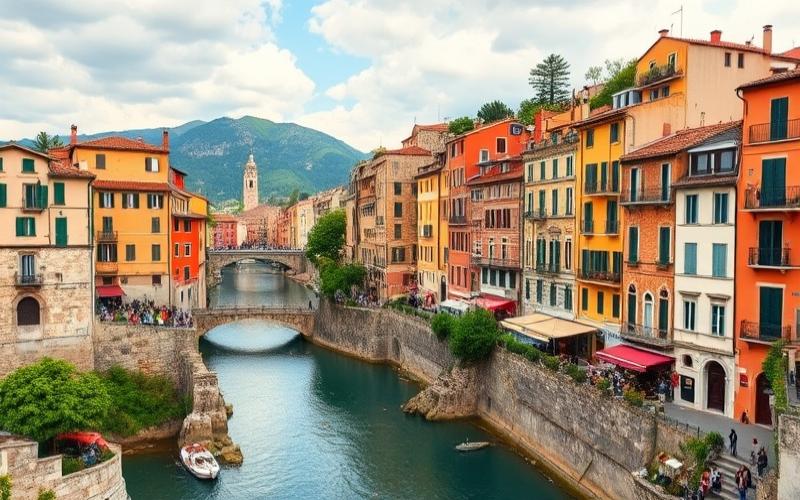
 Published on and written by Cyril Jarnias
Published on and written by Cyril Jarnias
In the ever-evolving realm of Italian real estate, understanding mandatory insurance can prove to be a significant challenge, whether you’re a new buyer or an experienced investor. With legislation that often differs from other European countries, it’s essential to demystify insurance options to ensure adequate protection for your property.
This article will dive into the heart of Italian regulatory complexities, while offering a clear comparison of different essential coverages. Discover how to confidently navigate these requirements to guarantee the security of your real estate investment.
Comparing Home Insurance in Italy
Home insurance policies in Italy are typically either multi-risk home insurance or basic type, with key guarantees like fire, water damage, theft, and civil liability, often supplemented with options (assistance, legal protection, glass breakage, natural disasters).
Main Types of Home Insurance
- Multi-Risk Home Insurance (MRH): extended protections for dwelling + contents, including fire, water damage, theft, vandalism, civil liability, assistance, with options for natural disasters and glass breakage.
- Basic Insurance: minimal coverage focused on fire/theft, often without additional guarantees or specific major perils.
- Civil Liability Insurance (private life/owner): damages caused to third parties by the insured, their family, or their pets; sometimes purchased separately or included in MRH.
- Frequent Extensions: glass breakage, legal protection/assistance, 24/7 assistance, natural events (earthquakes, floods, hail), with deductibles/regional specifics.
Coverages Generally Included in “Standard” Policies
- Material damage to the building and contents (fire, water damage).
- Civil liability of the occupant/owner.
- Theft and vandalism on contents, sometimes with limits per category.
- Assistance in case of a claim (craftsmen intervention, emergency repairs).
- Natural disasters: often partially included via fire guarantee (hail/cyclones), but earthquake and flood generally require specific guarantees, with notable pricing impact depending on the area.
Comparison of Major Insurance Companies (Price, Popularity, Coverage)
| Criteria | Traditional Companies (Network) | Direct/Digital Insurers | Specialists/Premium |
|---|---|---|---|
| Price | Medium to high; rate modulated by location and optional guarantees | Competitive on standard packages; à la carte options | Higher with extended guarantees (rare perils, valuable items) |
| Popularity | Strong local presence, in-person agency services | Growth via online subscription, simplicity | Niche, demanding clients |
| Coverage Level | Solid MRH + Civil Liability + assistance; modular CAT-NAT options | Good base (fire/water/theft/Civil Liability) + targeted options; digital process | Enhanced coverages (legal, glass breakage, broadened CAT-NAT), higher ceilings |
| Strengths | Claims support, network of craftsmen, clarity of guarantees | Price/agility, quick subscription, online transparency | Broad protection, rare options (collections, villas, secondary residence) |
| Weaknesses | Cost, sometimes slower processes | Sometimes stricter ceilings/conditions; variable assistance | High premium; more selective underwriting |
Comparative Points to Consider
- Coverage for earthquakes and floods varies significantly from one insurer to another and can be the main differentiator for price and protection depending on the area.
- 24/7 assistance and legal protection are comfort markers; their presence from the standard plan is a plus.
- Online “basic” plans cover the essentials but customization (high-value contents, precious objects) leads to additional costs.
Current Market Trends in Italy
- Rise in natural disaster options: increased demand for earthquake/flood coverage in exposed regions; premium increase effect when added.
- Digitization of subscription and claims management: simplified online process, quick quotes, growing popularity of direct insurers.
- Modular packages: standard base + modules (legal, glass breakage, enhanced assistance, extended Civil Liability) to adjust price/coverage.
- Focus on assistance: emergency services and craftsmen networks highlighted as differentiating value.
Factors Influencing Pricing
Geographical Location
- Seismic zones (e.g., center/south, Apennines) and flood-prone areas: surcharges or specific mandatory guarantees for coverage, higher premiums.
- Urban vs. rural: higher theft risk in cities impacting theft guarantee.
Property Characteristics
- Type (apartment vs. house), surface area, content value, security level (locks, alarms), materials and year of construction influence the base premium.
- Secondary residences and vacation homes: separate contracts and dedicated pricing.
Chosen Coverage Level
- Adding options (earthquake, flood, legal, valuable items) and increasing ceilings/lowering deductibles raise the premium.
Insured Profile and Claims History
- Claims history, occupancy (owner/tenant), and insured capital adjust the rate.
Legal Obligations and Impact on Consumer Choice
Home insurance is not legally mandatory in Italy for occupants, but it is highly recommended and sometimes contractually required (lease, condominium).
Certain protections may be required by third parties:
- Landlords: requirement for tenant liability/theft according to the contract.
- Condominiums: coverage for common areas/owner’s liability sometimes requested.
Consequence on choices:
Consumers balance price and coverage breadth, with increased sensitivity to Civil Liability and assistance modules to meet contractual requirements, and to CAT-NAT guarantees in risk areas to avoid major exclusions.
Quick Checklist Before Subscription
- Level of Civil Liability (ceiling/exclusions), basic perils included (fire, water, theft).
- Presence of key options: earthquake/flood, 24/7 assistance, legal protection, glass breakage.
- Conditions for secondary residence and property value; required documents (tax code, housing/family information).
Good to Know:
In Italy, home insurance offers varied coverages generally including protection against theft, fire, and water damage. Among major companies such as Generali, UnipolSai, and Reale Mutua, notable disparities are observed in terms of price and coverage, with Generali being renowned for its popularity and wide range of services while Reale Mutua stands out for its competitive offers on standard policies. The price of insurance can vary depending on location, with urban areas often being more expensive, and property characteristics, such as age or type of construction. Currently, the market shows a trend towards policy customization to better meet specific client needs. Although home insurance is not legally mandatory in Italy, it is highly recommended, especially in condominiums, influencing consumers to choose policies adapted to their personal and regional situation.
Understanding Italian Property Owner Liability
The legal basis for property owner liability in Italy rests primarily on the Civil Code (general duty of care and liability for damages caused by property), condominium law, and special rules regarding construction site safety and urban planning. Property owners must notably maintain the property, respect condominium regulations, guarantee safety and habitability, act in good faith in transactions, and comply with urban planning and construction rules.
Legal and Regulatory Obligations
- Respect of condominium regulations (use of common areas, charge distribution, assembly decisions).
- Obligation to maintain and secure the property to avoid damages to third parties and neighbors.
- Duty of good faith and disclosure during sales (technical documents, urban planning and construction compliance).
- Compliance with urban planning and construction standards; non-compliance can lead to contract annulment and penalties.
- Construction site safety: when directly employing a worker (e.g., painter), the owner assumes employer obligations regarding risk prevention and can be held civilly and criminally liable in case of an accident.
Situations Engaging Civil Liability
- Damages caused by the property (fall of a facade element, water infiltration originating from the dwelling).
- Nuisances in condominium (non-compliance with regulations, abnormal use of common areas, non-compliant work causing damage).
- Construction defects affecting structural integrity or causing serious faults: ten-year liability of the contractor towards the purchaser, with specific reporting deadlines and statutes of limitations, potentially involving the owner-seller during transfers if disclosure and compliance obligations are not met.
- Accidents on a domestic construction site when the owner acts as a de facto employer (lack of safety measures, failure in coordination).
Concrete Examples
- A roof tile detaches and injures a passerby: failure to maintain the roof engaging the owner’s liability towards the injured third party.
- Water infiltration from an apartment damaging the neighbor’s ceiling: liability of the source apartment’s owner, with potential involvement of the condominium if a common part is involved.
- Painting work without protections (unsafe scaffolding) and fall of a worker hired directly by the owner: civil and potentially criminal liability of the owner as employer, due to lack of adequate safety measures.
- Sale of a property non-compliant with urban planning not disclosed to the buyer: risk of sales agreement annulment and compensation; violation of the duty of disclosure and good faith.
- Discovery of serious structural defects within 10 years of completion: action against the contractor under ten-year liability, with specific reporting deadlines and statutes of limitations.
Consequences in Case of Non-Compliance
- Compensation for damages to third parties and neighbors (repair of material and bodily harm).
- Sanctions and nullities in urban planning matters (annulment of acts, financial penalties).
- Civil and criminal liability in case of a workplace accident on a domestic construction site where the owner is the de facto employer.
- Condominium disputes (charge appeals, actions to cease disturbances, execution of urgent work).
Importance of Subscribing to Property Owner Liability Insurance
In Italy, “home insurance” is not legally mandatory, but it is highly recommended to cover civil liability towards third parties and many common claims (water, fire, etc.).
This coverage allows handling claims from neighbors, passersby, and third parties for damages caused by the property or by work, and to fund legal defense.
Simplified Comparison Table of Market Offers in Italy
| Criterion | Home Insurance (Owner Liability) | Condominium Liability (Building Policy) | Construction/Work Site Liability |
|---|---|---|---|
| Scope | Damages caused to third parties by the dwelling, private life, often water damage/fire | Covers common areas and liability of the syndicate/condominium | Coverage for damages related to work and safety |
| Who Subscribes | Owner or occupant | Condominium (syndicate) | Owner and/or contractor |
| Points of Attention | Ceilings, deductibles, exclusions (work, lack of maintenance) | Limits on private areas, specific exclusions | Prevention requirements, employer obligations, contractual liability |
| Main Advantage | Financial protection in case of damages to neighbors/third parties | Mutualization of common risks | Dedicated coverage for construction site risks |
Main Providers and Typical Offers in Italy
- Generalist companies present in home insurance: offers including private life/owner civil liability, water damage, fire, legal defense, assistance.
- Specialized agencies/insurers in condominium: comprehensive building policies subscribed by the syndicate, with extensions for condominium liability and damages to common areas.
- Specific insurance for work: “cantiere” policies or work site extensions to existing contracts; contracts with contractual transfer of safety obligations to the contractor via dedicated clauses.
Selection Criteria to Prioritize
- Sufficient liability guarantee ceiling for serious bodily injury and serial damages.
- Deductibles and sub-limits, notably for water damage, infiltration, and tenant/neighborhood liability.
- Key exclusions: structural work, lack of maintenance, professional activities, subcontracting.
- Useful extensions: defense and recourse, neighbor’s loss of use, legal protection, emergency assistance.
- Coordination with the condominium policy: avoid coverage gaps between common and private areas; verify coordination of condominium guarantees.
- Construction site coverage: dedicated policy or explicit transfer to the contractor’s contract; verification of insurance certificates and safety obligations.
- Compliance and documentation: ensure urban planning compliance and disclosure obligations in case of sale to limit ancillary legal risks.
Important Note
- Keep assembly minutes, condominium regulations, and maintenance certificates to prove diligence and limit exposure in case of a claim.
- In case of work, formalize in writing the transfer of safety obligations to the contractor, demand their insurance certificate, and monitor prevention measures.
- Before any sale, gather urban planning and compliance documents and disclose all relevant information to the buyer to avoid nullities and penalties.
Good to Know:
In Italy, property owner liability is primarily governed by the Civil Code, which obliges owners to ensure their properties do not cause harm to others, notably through adequate property maintenance. Typical risk situations include damages caused by falling trees or the collapse of defective structures affecting third parties or neighbors. In case of non-compliance, owners can be held financially responsible and even face legal proceedings. Subscribing to civil liability insurance is therefore crucial; this insurance covers costs related to such incidents. In Italy, several insurers like Generali, UniSalute, and Reale Mutua offer varied offers. When selecting insurance, it is essential to compare coverage ceilings, exclusions, and the provider’s reputation. Adequate insurance not only protects the owner from the financial consequences of an incident but also offers valuable legal security.
Essential Coverages for Rental Risks in Italy
The essential coverages recommended for rental risks in Italy mainly include: damage to the real estate property (fire, water damage, natural disasters, theft/vandalism), civil liability, legal protection, and, for rentals, specific options like unpaid rent guarantee and defense-recoupment in case of dispute with the tenant; these guarantees are generally available via multi-risk home insurance policies and their optional extensions. Italian law does not make home insurance mandatory for owners or tenants, but it is highly recommended; certain guarantees (e.g., earthquake/flood) must be explicitly added and can increase the premium depending on the risk zone.
Key Guarantees to Prioritize for a Landlord:
- Damage to the building (fire, water damage, weather events, theft/vandalism): protects the structure and often the contents provided with the dwelling.
- Civil liability (CL) of the owner: covers damages caused to third parties (tenants, neighbors) due to the rented property.
- Legal protection/dispute assistance: coverage of costs and assistance in case of conflict (e.g., disputes, neighborhood disturbances).
- Natural disasters: often a separate option for earthquake and flood; to activate based on location.
- Unpaid rent guarantee (if offered): increasingly frequent option in “rental” offers or via specialized insurers; check deductible, ceilings, and waiting periods.
- 24/7 assistance and emergency repairs: useful for plumbing/electrical emergencies and claim management during the lease.
Summary Table of Priority Protections
| Landlord Need | Guarantee to Look For | Points of Attention |
|---|---|---|
| Protect the structure | Fire, water damage, weather events, vandalism | Rebuild value, exclusions (infiltration, wear and tear), deductible |
| Seismic/flood risk | Natural disasters | Often optional; rate depending on the zone |
| Liability towards third parties | Owner Civil Liability | Ceiling per claim, exclusions (construction defect) |
| Rental disputes | Legal protection | Cost ceilings, covered domains (lease, recovery) |
| Unpaid rent | Unpaid rent guarantee | Waiting period, indemnification duration, covered rate; sometimes via dedicated options |
| Emergency management | 24/7 assistance | Intervention times, types of craftsmen included |
Quick Comparison of Coverage Approaches and Cost Among Typical Market Players
- Generalist “multi-risk home” insurers:
- Coverage: standard package (fire/water/theft/Civil Liability) + earthquake/flood options, legal protection, assistance; sometimes extensions for secondary residence or contents.
- Cost: varies significantly by location and property type; indicative observations for secondary residences/expats: simple urban apartment around 90–200 € annually, houses/villas higher 240–700 € depending on size and tourist region.
- Strong points: assistance network, modularity of options; limits: “unpaid rent” guarantees not systematic in classic MRH.
- Insurers/products oriented towards natural risks:
- Coverage: earthquake/flood as separate option, sometimes partially integrated into fire for certain perils (hail/winds); earthquake and flood require a dedicated addendum.
- Cost: notable surcharge in seismic or flood-prone zones; evaluate risk maps before subscription.
- Offers for landlord owners (according to catalog):
- Coverage: addition of “lease” legal protection, rent and dispute assistance, sometimes unpaid rent guarantee via specific module; check tenant eligibility conditions.
- Cost: additional premium vs. standard MRH; depends on indemnification ceilings and waiting periods.
List of Criteria to Choose the Best Insurance Based on Your Situation
- Property location:
- Seismic/flood-prone zone: prioritize natural disaster option and adapted ceilings.
- Property type and usage:
- City apartment vs. isolated house vs. tourist residence: adjust building/contents capital and theft/vandalism.
- Rental profile:
- Long-term vs. short-term (touristic): require extended legal protection and assistance; consider unpaid rent guarantee for long-term leases.
- Budget and risk tolerance:
- Choose higher deductible to reduce premium; verify rebuild value and Civil Liability ceilings.
- Service and claims management:
- Availability of 24/7 assistance, network of craftsmen, handling times.
- Clauses and exclusions:
- Earthquake/flood not included by default; check exclusions on progressive water damage, lack of maintenance, construction defects.
Relevant Italian Legal Information
- Mandatory nature:
- Home insurance is not legally mandatory for owners or tenants, but it is strongly recommended to prevent disputes and cover private life Civil Liability.
- Natural disasters:
- Earthquake/flood coverage is not automatic; it is subscribed as an additional guarantee in most policies.
- Market practices:
- Modular multi-risk policies covering building and contents, with theft, legal protection, and assistance options; key terminology: “polizza” (policy), “franchigia” (deductible).
Concrete Examples of Scenarios and Mitigation by Insurance
- Water damage from an old pipe affecting the neighboring apartment:
- Indemnification for repairs in your dwelling + Civil Liability for damages to the neighbor; assistance to find an emergency plumber.
- Fire in the rented kitchen, partial destruction of provided furniture:
- Fire guarantee for structure and insured contents; refurbishment costs covered according to capital; legal protection in case of dispute over the origin.
- Theft with break-in at a short-term rental pied-à-terre:
- Theft/vandalism guarantee for contents; lock reinforcement via assistance; Civil Liability if damages to common areas.
- Earthquake in a risk zone causing structural cracks:
- Activation of natural disaster guarantee (earthquake) with appraisal and indemnification according to rebuild capital; specific deductible applicable.
- Tenant stops paying for 4 months:
- Unpaid rent guarantee (if subscribed) indemnifies according to ceiling and duration, after waiting period; legal protection for recovery/eviction procedure.
Practical Subscription Tips and Cost Optimization
- Accurately assess building/contents capital; avoid underinsurance which reduces indemnification pro-rata.
- Adjust the deductible to your cash flow; compare at least three equivalent modular offers.
- Verify essential options for your zone (earthquake, flood) and excluded by default.
- Require high Civil Liability ceilings if condominium and dense neighborhood.
- For long-term lease, request the unpaid rent option and “lease” legal protection; for short-term rental, prioritize assistance and theft.
Note on Indicative Costs
Order of magnitude observed for insured residential properties in Italy:
- Urban apartment 1–2 rooms: approximately 90–200 €/year depending on city and guarantees.
- Houses/villas: approximately 240–700 €/year depending on size/region and options (notably natural disasters).
Attention to Market Limits
Offers and prices vary by insurer and region; the unpaid rent guarantee is not systematic in all MRH and may exist via dedicated landlord products; carefully read conditions, deductibles, and exclusions.
Good to Know:
In Italy, coverage for rental risks often includes unpaid rent insurance and legal protection for disputes with tenants. For example, Generali and Allianz offer policies covering damage to the real estate property, but their rates vary depending on the subscribed guarantees. Landlords must assess their coverage needs based on the location and value of their property. Although home insurance is generally recommended for owners, unpaid rent insurance remains optional but highly recommended. According to Italian law, only civil liability insurance is mandatory. A common scenario is property damage by a tenant. Adequate coverage will compensate repair costs, while unpaid rent insurance secures the owner’s income in case of payment default. Comparing options allows choosing insurance that offers the best balance between cost and utility, while considering regional legal specifics.
Disclaimer: The information provided on this website is for informational purposes only and does not constitute financial, legal, or professional advice. We encourage you to consult qualified experts before making any investment, real estate, or expatriation decisions. Although we strive to maintain up-to-date and accurate information, we do not guarantee the completeness, accuracy, or timeliness of the proposed content. As investment and expatriation involve risks, we disclaim any liability for potential losses or damages arising from the use of this site. Your use of this site confirms your acceptance of these terms and your understanding of the associated risks.













































